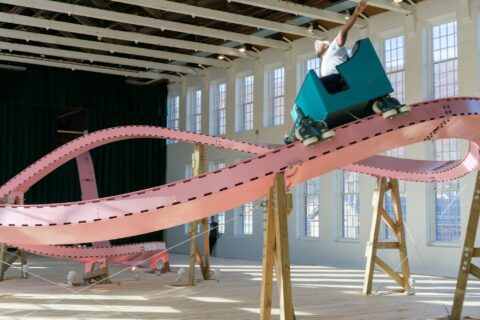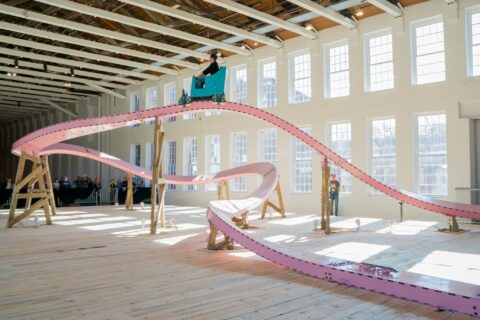
Tunechi the dog
Insta: mat13_

Great northern diver (Gavia immer)
Cariboo region, Canada
Photograph: Sue Dougherty

Images courtesy of Yamagata University
Following the discovery of an enormous lounging cat in 2020, archaeologists have uncovered hundreds of additional geoglyphs on the Nazca Lines site in Peru. A team from Yamagata University has spent nearly a decade at the location 250 miles south of Lima, and a field study between June 2019 and February 2020 unveiled 168 previously hidden works. Spotted in aerial photos captured by drones, the drawings feature myriad creatures like birds, snakes, orcas, and people likely created between 100 B.C. and 300 A.D.
Researchers believe there are two types of geoglyphs on the Nazca Pampa, a linear and relief, although only five documented during this mission are linear. Prehistoric populations created the works by removing darker stones from the earth’s surface to reveal the lighter sand below, and the renderings are thought to be part of spiritual, astronomical rituals. Spreading across 170 square miles, the Nazca lines vary in size, although most are smaller than 30 feet in diameter.
Archaeologists have spotted 358 geoglyphs at the UNESCO World Heritage site so far, which is currently being studied to see how the works are distributed across the area. (via ArtNet)



Do stories and artists like this matter to you? Become a Colossal Member today and support independent arts publishing for as little as $5 per month. The article Archaeologists Uncover Nearly 170 Nazca Lines Dating Back About 2,000 Years in Peru appeared first on Colossal.

Gérard Schlosser (French, born in 1931)
Charlus, 1971
Acrylic on sanded canvas, 150 x 150 cm.
“When considering whether to buy yet another book, you might well ask yourself when you’ll get around to reading it. But perhaps there are other, even more important considerations, such as the intellectual value of the book in its still-unread state.”
The Virtue of Owning Books You Haven’t Read: Why Umberto Eco Kept an “Antilibrary”


OMG! I want to ride EJ Hill’s Bubblegum Pink Roller Coaster Through a Mass MoCA Gallery. Says the woman who doesn’t like roller coasters.

All images © Levon Biss, shared with permission
A photographer known for using the macro to investigate the micro, Levon Biss (previously) continues his explorations into the vast world of entomology. His recent butterfly pupae series centers on “the diversity of design and form” through illuminating portraits of approximately 30 specimens as they undergo metamorphosis and complete the final, most vulnerable stage of the transition from adolescence to adulthood.
Otherworldly and bordering on the bizarre, many of the chrysalises have evolved to be deceptive in appearance, acting as necessary camouflage from potential predators by impersonating nearby plants and surroundings: some mimic the natural, like those that imitate a rotting plantain or mossy hunk of bark, while others are more artful, like those spotted with Kusama-esque dots or cloaked in a mirrored gold coating. The photographs are “intended to be both entertaining and educational,” Biss shares, “allowing the viewer to appreciate the diversity in the subject whilst appreciating the intricate details that evolution has created.”
Pick up a print of the unearthly images, and find more from the collection on Biss’s site and Instagram. If you’re in New York, you can also see his Extinct and Endangered series at the American Museum of Natural History.






Do stories and artists like this matter to you? Become a Colossal Member today and support independent arts publishing for as little as $5 per month. The article Photographer Levon Biss Illuminates the Strange, Otherworldly Chrysalises of Butterfly Pupae appeared first on Colossal.
Whoa! The RGB Colorspace Atlas by New York-based artist Tauba Auerbach is a massive tome containing digital offset prints of every variation of RGB color possible.

All images © Stéphan Gladieu, shared with permission
“So dramatic, so strong, so visual,” artist Stéphan Gladieu said of his first encounter with the revival of an ancestral folk art movement in Kinshasa, Democratic Republic of Congo. Kinshasa is the capital of Congo but also one of the many places American and European countries send their waste. Though doing so is illegal, wealthier nations still export tons of debris with the knowledge that these places do not have the resources to treat or recycle it. Instead, these discards sit, swell, and slowly drown everything around them.
In the face of this ecological disaster, the young people of Kinshasa began to repurpose the waste into traditional religious costumes that were previously destroyed, along with other cultural histories and rituals, by the forced Catholicism of colonization. Gladieu’s relationship with these artists has evolved into the Homo Détritus series.
“(In the photographs), we are talking about ecology, but we are talking about ecology through African masks. As you can see, they’re completely covered up. You don’t see any part of the skin. The traditional masks were done with natural materials. They symbolized the spirit of the ancestors or the spirit of support of the natural world. These young artists reinvent these traditional masks in a way, but they do it today with trash because they find more trash and natural materials.”

While doing research in Yoruba for a different photo project that has yet to be released, Gladieu found some grainy photos of a girl dressed in plastic bottles. After reaching out to the contact, he discovered that several of these outfits already existed in Kinshasa and were being produced by local artists as a cultural response to the growing waste problem. However, some of them were damaged due to the lack of resources to properly store the pieces. The labor ranged widely. It could take a few days to repair a mask or when working in groups of three to four people. When using plastics like the shoes seen in “Babouch” (“Flip-Flop”), costume construction could average five to six days. The most complex garments made of tires, bottles, and metal scraps took up to three to four weeks.
In “Homme Bidon,” which translates to “Phony Man,” brightly colored cups, water containers, and buckets form a mask. With two pails in each arm, the figure balances a water bucket on top of its head. The opening of a yellow container becomes a mouth, and a perforated top represents its eyes—creating a pained expression that also evokes thirst. To the left of the figure, there is a woman in a yellow chair pouring water into her hands. This image references the inequitable economics of water that disproportionately affect poorer countries like those across Sub-Saharan Africa where, as of 2020, 30 percent of people have access to safe drinking water. The surrounding environment also nods to the gendered divisions of women and girls who are responsible for gathering this vital resource for their communities.
The young artists of Kinshasa and Gladieu’s photographic approach set this project apart from other ecological art concerning this region. “I didn’t want to do work that would be dark. A lot of work had been done like that,” Gladieu said of wanting to avoid guilting viewers into paying attention. “People don’t want to see and don’t really react anymore to those images. It doesn’t help them realize that we all have a personal responsibility in the way we consume and throw things away.” This approach also better honors the agency and resilience of the community of Kinshasa. It exalts the reclamation of their culture rather than the systemic violences enacted against them.

“L’Homme Caoutchouc” (“The Rubber Man”) calls out industrial companies that are not relegated to strictly enforced environmental regulations. This charge is captured in the figure’s monstrous stance, rugged form, and emergence from a pool of oil black mud. Similarly, “L’Homme Sachet” (‘The Bag Man”) speaks to the way the plastic bag engulfed many developing countries and quite literally consumed land, animals, and water sources. The abundant layers and repetitive colors represent the excess of plastic that hungrily survives even after we have tossed it into our garbage cans and out of our minds. Along with the depth of representation, Gladieu’s portrait style captures the magnitude of each figure’s artistic presence. He attributes this accomplishment to the collaborative nature of the project.
“I was living with (the artists in Kinshasa). We chose the materials, and I helped provide the money to build a costume or to repair the ones that were damaged. Then we worked in the city to choose the backgrounds. And when I say it’s a collaborative project, it’s also in terms of income because there is a part of the money that I can send by doing speeches and books. It’s a wonderful experience, even if it’s not easy. There are 25 artists. So sometimes it’s a mess, but it’s quite fun.”
You can see more of Homo Détritus on Gladieu’s website, Instagram, or by pre-ordering his forthcoming monograph, which will be released in November.







All images by Michael Wicks, courtesy of Batsford
From gathering and retting stinging nettle to stitching leaves into delicately layered quilts, Wild Textiles: Grown, Foraged, Found is a trove of tips and projects involving organic fibers. The forthcoming book by artist Alice Fox is a practical guide to working with nature’s materials at all steps of the process: she offers advice on growing plants and harvesting others, how to transform the raw matter into cord or thread, and examples of artworks that incorporate the repurposed textiles. Published by Batsford, the volume covers both rural and urban findings, in addition to pieces by artists like Hillary Waters Fayle and Penny Maltby. Wild Textiles is available for pre-order on Bookshop.


Work by Hillary Waters Fayle





